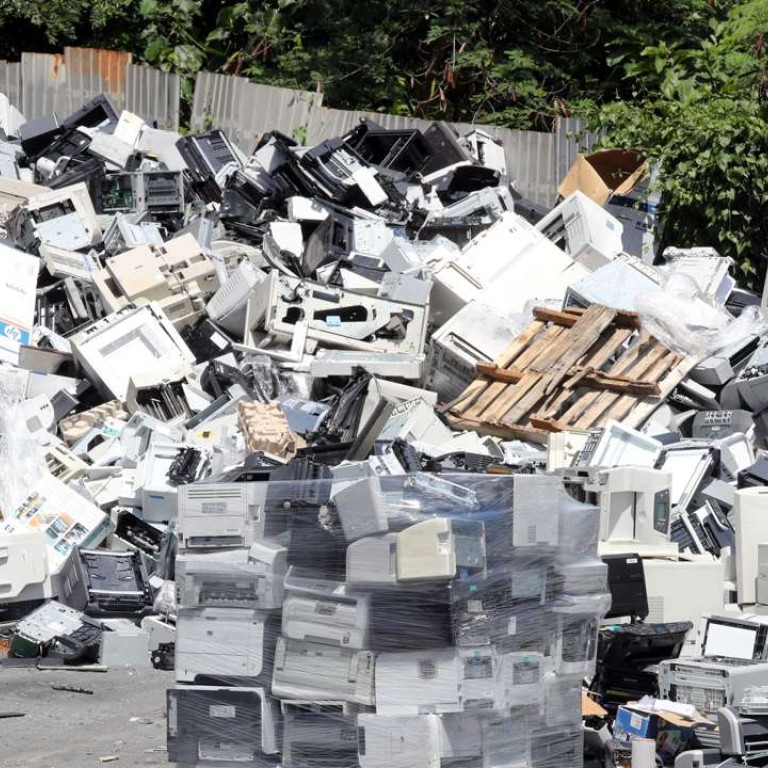
Turn back the e-waste tide: pressure to stop flood of toxic imports from US to Hong Kong
Dump sites in the New Territories are still operating, months after campaigners handed list of offenders to the Environmental Protection Department
Environmental officials in Hong Kong and the United States are coming under increasing pressure to stem a growing tide of potentially lethal electronic waste entering the city amid fears it could replace Guangdong province as the dumping ground of choice for the global digital economy.
Months after campaigners against electronic waste handed the Environmental Protection Department a list of dump sites in the New Territories, the Sunday Morning Post has discovered that most of them are still operating.
The 10 sites were identified by the US environmental watchdog Basel Action Network in May after hazardous materials were tracked using special GPS satellite trackers planted in shipping containers leaving the US.
Clustered in Yuen Long – some of them close to livestock and arable farming – the dump sites, which also serve as wrecking and salvaging yards for computer parts, LCD monitors and an assortment of potentially hazardous material, were visited by the Post late last month (see accompanying story below).

A spokesman for the EPD said: “We are in touch with the US Environmental Protection Agency and the indications are that the agency and other US federal agencies are concerned about the flows of used electronics from the United States to countries that have laws restricting their imports.
“The department has just begun exchanging information with the US authorities on how to step up the collaboration on controlling illegal transboundary movement of waste between Hong Kong and the US.”
The move follows a two-year investigation by the network which found that 37 out of 65 items had been exported from the US. Another eight were tracked to mainland China.
The research suggests a significant geographical shift in the movement of electronic waste – the bulk of which a decade ago would end up on the mainland.
Over the last year, the mainland has stepped up controls preventing e-waste from entering via the Hong Kong-Shenzhen border, such that legislators, environmental activists and concern groups suspect that the materials are now stuck in Hong Kong.
A spokesman for the EPD said when they received the information from the network in May they began an investigation. “Even if the sites are processing non-hazardous waste, such as printed circuit boards, if the process causes pollution to the environment, the department will also take action in accordance with the law,” he said.

“In the brown fields in the New Territories, everything is out of control,” said district councillor Paul Zimmerman who described the area close to the Shenzhen border as a hotbed of smuggling activity and an open market for commodities stripped from imported electronic materials.
“This kind of activity is happening on a grand scale and its causing mayhem to the area,” he said.
Key identifiers suggested that much of what was being processed there had been imported from the US, including US plugs lying among the debris, and labels indicating the items were American.
A shipping container parked outside was traced back to originating from Florida in the US using an online shipping database.
The import of hazardous electronic waste into Hong Kong is illegal under the Basel Convention, which regulates the flow of hazardous materials across international boundaries. Both Hong Kong and mainland China are signatories, but the US has not ratified the convention,
Hong Kong’s legal definition of “hazardous” waste is uniquely lax, providing loopholes in legislation that make the its free-wheeling container port a popular destination for the products.
“E-waste is classified into two categories under the Basel Convention – non-hazardous e-waste and hazardous e-waste,” an EPD spokesperson said. “Non-hazardous e-waste includes main computer units, computer hard disks, other component parts inside a computer, printed circuit boards, printers and servers etc.”
Network director Jim Puckett estimates around 50 to 100 containers arrive each day containing e-waste and that 90 per cent of the material found at dumps in the New Territories are US exports.

